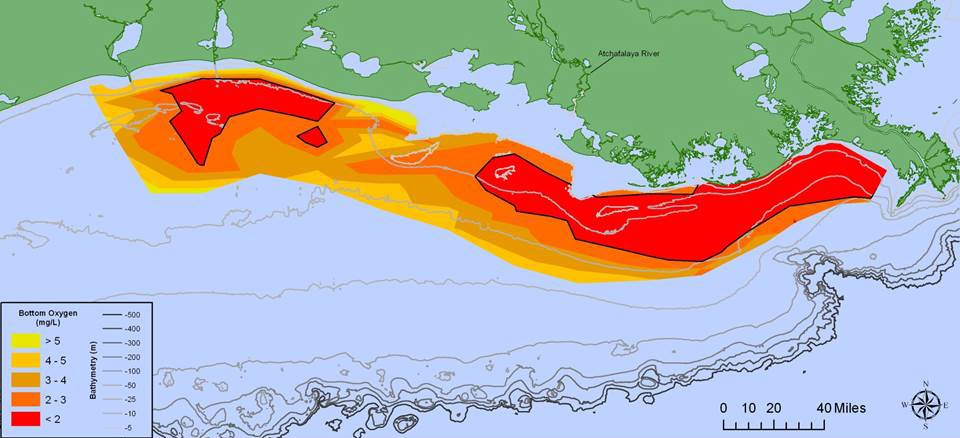NOAA-, EPA-Supported Scientists Find Average But Large Gulf Dead Zone
Mapped size confirms NOAA forecast for an average-sized hypoxic zone this year

Bottom-water Dissolved Oxygen for 2014
Distribution of bottom-water dissolved oxygen for July 27-Aug. 1, 2014 (west of the Mississippi River delta). The black line in this graphic indicates dissolved oxygen level of 2 milligrams per liter (mg/L). | Download
Data source: Nancy N. Rabalais, Louisiana Universities Marine Consortium (LUMCON), and R. Eugene Turner, Lousiana State University. Funding: NOAA and U.S. Environmental Protection Agency.
NOAA- and EPA-supported scientists have measured the 2014 Gulf of Mexico dead zone, an area with low oxygen water, to be 5,052 square miles—approximately the size of Connecticut. The measurements were taken during the 30th annual hypoxia survey cruise from July 27 to August 2.
This area falls within the predicted range of 4,633 to 5,708 square miles forecast by a suite of NOAA-sponsored models and confirms the accuracy of the models and their utility for guiding management of nutrients in the Mississippi River watershed.
The size is smaller than the 5,840 square miles recorded last year but still greater than the Mississippi River/Gulf of Mexico Watershed Nutrient (Hypoxia) Task Force target of less than 1,900 square miles—meaning nutrients from the Mississippi River watershed are continuing to affect the nation’s coastal resources and habitats in the Gulf. The task force consists of five federal agencies, 12 states, and the tribes within the Mississippi/ Atchafalaya River Basin, and was established in 1997 to reduce and control hypoxia in the Gulf of Mexico.
The largest Gulf dead zone ever recorded occurred in 2002, encompassing 8,481 square miles. The smallest recorded dead zone measured 15 square miles in 1988. The average size of the dead zone over the past five years has been about 5,500 square miles.
The annual measurement mapping of the dead zone provides a critical scientific record of the trend of hypoxia in the Gulf, as well as the primary measure of progress used by the Hypoxia Task Force to determine whether efforts to reduce nutrient loading upstream in the Mississippi River Basin are yielding results.
The hypoxic zone off the coast of Louisiana and Texas forms each summer threatening the ecosystem that supports valuable commercial and recreational Gulf fisheries. NOAA-funded research in the past decade shows hypoxia results in habit loss, displacement of fish (including shrimp and croaker) from their preferred areas, and a decline in reproductive ability in some species.
Visit the Gulf Hypoxia website for additional graphics and information concerning this summer’s LUMCON research cruise and previous cruises.
NOAA’s National Ocean Service has been funding monitoring and research for the dead zone in the Gulf of Mexico since 1985 and currently oversees the NGOMEX program, the hypoxia research effort for the northern Gulf which is authorized by the Harmful Algal Bloom and Hypoxia Research and Control Act.
Get Social
More Information
Did you know?
Dead zones, also called hypoxic areas, are caused by nutrient runoff from agricultural and other human activities in the watershed and are highly affected by river discharge. These nutrients stimulate an overgrowth of algae that sinks, decomposes, and consumes the oxygen needed to support life in the Gulf. Learn more
